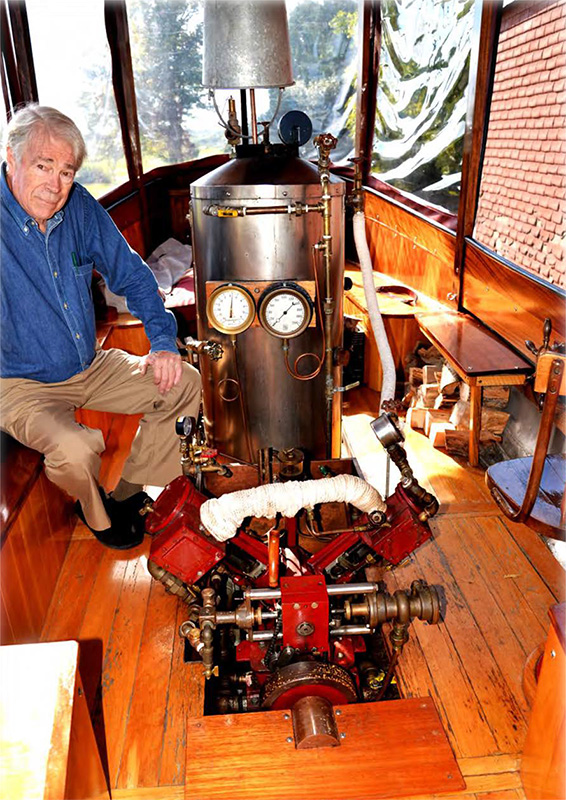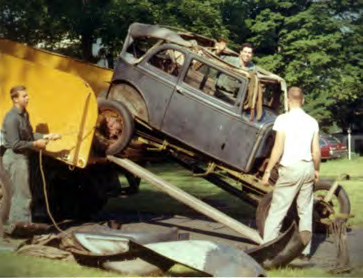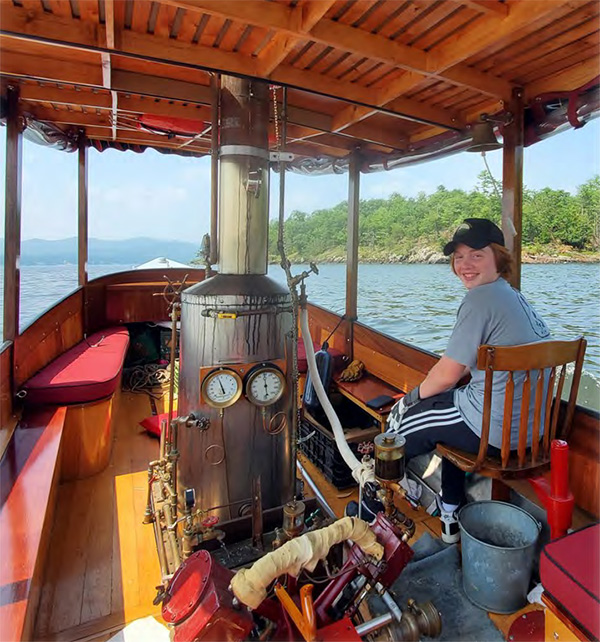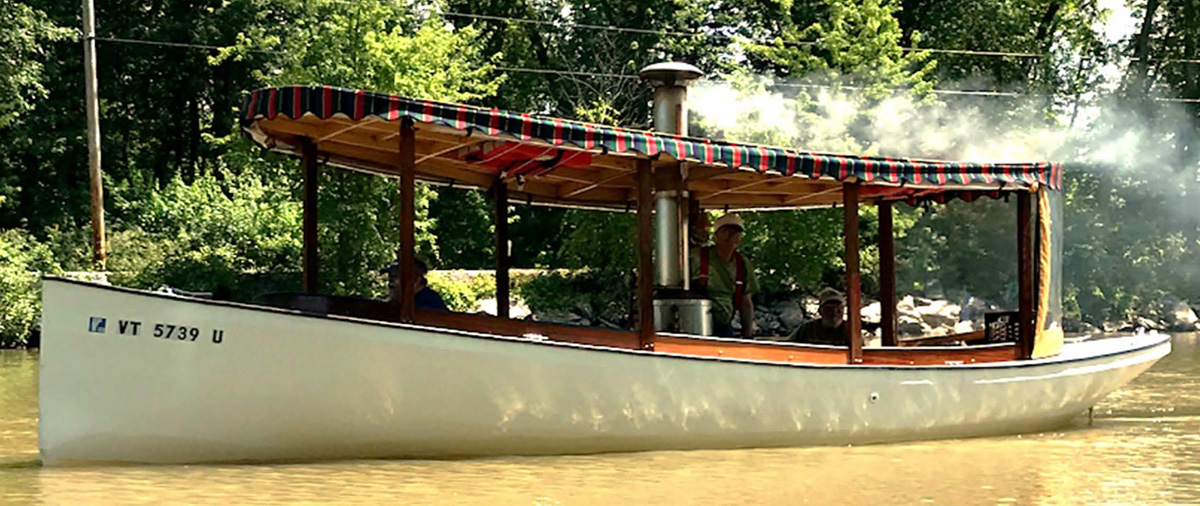
Ralph Shepard lives in Ferrisburgh, VT not far from Otter Creek where his steam boat resides most summer days. Ralph is pictured at left.
Ralph and Pat’s home is one of those special places where you want to stay for a while because there is a lot going on. Adventures can be felt all around!
Thank you for giving Wheel Tracks this wonderful steamy story Ralph.
The boat is wood fired and under normal conditions it takes 20 to 25 minutes to build enough steam pressure to get underway. I store fuel in old plastic milk crates and can cruise about 6 mph burning one crate full per hour.
Back in the 60’s my brother Larry and I both restored antique cars, he a 1931 Model A coupe and I a 1926 Model T Coupe. As children we played with model steam engines including a stationary engine, steamboat, and even had an “O” gauge live steam locomotive. A late 50’s issue of Popular Mechanics featured a story about a 16’ home-built steam launch and that planted a seed that took a long time to germinate.
Fast forward 60 odd years: I discovered members of the North American Steamboat Association held a July meet only a few miles from my home. My brother knew several of the members and arranged an introduction to the group. My wife and I attended several gatherings and became intrigued by the quiet elegance the boats displayed. After a few rides I became determined to build one. I found an engine and boiler on eBay and brought them home in 2012.The only real challenge I faced was some back pressure at home. My wife was insistent that before I buy or build a boat, I finally complete the 1931 Ford Convertible Sedan I’d owned since 1965. That seemed a reasonable request and she also insisted I build a boat shed before it arrived so we’d not have something sitting in the yard.

As luck would have it, I found a boat needing restoration before the A-400 was done, so to keep it from getting away, I loaned my brother the money to buy it and he kept it at his house until my tasks were finally completed! The Model A was completed in time to drive it in the Vergennes Memorial Day Parade exactly 51 years after the weekend I brought it home (that may be a story for a future issue).
The shed was completed and the boat showed up shortly thereafter. Luckily, by removing the boat from its trailer it also fit into my shop. I began by stripping the hull of the old components and sold them to other hobbyists. I then concentrated on rebuilding the eBay engine and boiler. Never having owned a vertical fire tube boiler before I was baffled by all the empty pipe fittings mounted on the outside. Around 2012 I began inviting the visiting steam boaters to my home for a picnic during their annual visits. In 2014 after burgers and beers I gave them a magic marker and they drew a plumbing diagram on the stainless-steel shroud surrounding the boiler. With that guidance and pictures, I had taken of other boats, I was able to design, build, and assemble all I needed for a smooth-running closed loop system. The reason I say closed loop is that steam exiting the engine after it has expanded once the in the smaller high cylinder and again in the larger low-pressure cylinder is sent through a heat exchanger and condenser where it returns to water. The water is then sucked out of the condensing lines and fed back into the boiler through the heat exchanger.
The design is an American classic fantail steam launch from around 1900. The length is 25’ 11”, it measures 7’ 10” across the beam. The hull is 11-gauge 6061 aluminum with 5/16” reinforcing ribs and is one of five made in Ontario Canada ca. 1980-1. An original hull too far gone for restoration was used as the pattern. The engine is a compound V design with a 3” diameter high pressure cylinder with a 5” stroke, the low-pressure side has a 5” cylinder. Connecting the two cylinders is a “receiver tube” that hold the exhaust steam from the high-pressure side until the crankshaft rotates 90 degrees and allows the low-pressure cylinder to receive it. It is rated at 10 horsepower. The boat is wood fired and under normal conditions it takes 20 to 25 minutes to build enough steam pressure to get underway. I store fuel in old plastic milk crates and can cruise about 6 mph burning one crate full per hour. The key factor in controlling the boat’s speed is not the throttle, but boiler management. The boat’s speed has a direct lineal correlation to the temperature in the smoke stack. At 500 degrees F it will do 5 MPH and at 600 degrees 6 MPH etc. The engine has 4 power strokes per revolution and drives a steep pitch propeller 24 inches in diameter. Because of the high torque 5 MPH can be maintained at about 270 PRM.
Water is a natural lubricant so the steam chests and cylinders don’t need much additional help and the bottom end of the engine has sealed roller bearings on the rod and main journals. An oil drip supplies a few parts of the engine and is recovered by an absorbent membrane.

For creature comfort there is a “head” hidden under the horseshoe bench in the aft section of the boat. Often, we’ll spend a day on Lake Champlain and grill our lunch over the coals in the boiler. For a varied menu we have “pie pans” that are shallow cast iron pans hinged on one end with long handles. These make wonderful grilled cheese sandwiches! Another option is a two-sided wire grill used to hold fish, steak, or burgers. Finally, there is a copper coil immersion heater for brewing tea or heating soup. We can take short overnight cruises by moving the rear cushions to the bow section and making a double bed on top of the milk crates… which also serve as the base for a fold up dining table.
As you can imagine, even a killing frost might raise havoc with the plumbing unless the boat is in the water. Consequently, I must be very careful to drain all the water lines when it is pulled for the summer. On occasion when I have a dock available, it can safely remain in the water through October. The aluminum hull will absorb enough heat from the water the keep the in-side of the boat well above freezing when the side curtains are down.
The boat is wood fired and under normal conditions it takes 20 to 25 minutes to build enough steam pressure to get underway. I store fuel in old plastic milk crates and can cruise about 6 mph burning one crate full per hour.


Leave a Reply